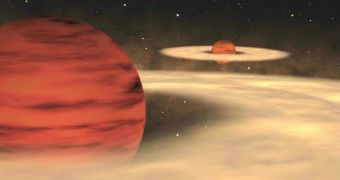New models regarding the solar system formation argue that certain solar systems might exist without a central star, or might have incredibly small, faint stars. The evidence was found while studying models of miniature versions of the solar system, results suggesting the other existing solar systems would not necessarily need to look like our own.
Astronomers discovered the stars are not essential for a solar system to form, but a massive object called a planemos (planetary mass object) with a size comparable to the size of planet Jupiter, could take the role of a central object, around which planets could form. Even our solar system could have been much stranger than thought, if Jupiter would have been at least ten times larger than its current size it could have potentially light up, and we would lived in a so-called binary solar system, it which one star orbits the other. However, the presence of a second star could have prevented the solar system to form other planets.
For such miniature solar systems to exist, astronomers believe the central object or planemos would have to have at least the mass of 1 percent that of the Sun. The first planemos was discovered in the year 2000, and have been since then a hot topic, for scientists. Observations show that these could be extremely small stars of giant gas planets, that have been kicked out of other solar systems while passing through gravitational keyholes.
The new study conducted by Dr Alexander Scholz, SUPA Advanced Fellow at the University of St Andrews, and Professor Ray Jayawardhana, from the University of Toronto, now suggests that the most likely scenario through which these solar systems formed, involve the collapse of a relatively small gas cloud the forms a central object roughly the size of Jupiter, around which other planets may form.
So far the astronomers have observed 18 such planemos in the 3 million year old Orion star cluster. The time it takes for a star to complete the planet forming process is about 10 to 50 million years, meaning that most of the stars in the Orion cluster are relatively young and are still surrounded by accretion disks of dust and gas that could spawn new planets. The accretion disks are visible in the infrared domain, due to the fact that they are extremely hot.
The results show that about one third of the planemos observed have dusty accretion disks, which resemble the models of young solar system formation, indicating that for a solar system to form they don't need massive central objects, like stars. The main motivation of the research of these miniature solar systems is to answer the question of how small a planemos could be, to create planets around it.

 14 DAY TRIAL //
14 DAY TRIAL //